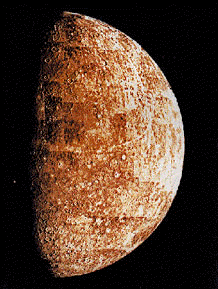This is a false color image of a mosaic of Mercury.
Click on image for full size
Courtesy of NASA.
Mercury's Interior and Surface
Mercury, the innermost planet of the solar system, is a little
bigger than the Earth's Moon. The
surface
of the planet is covered with craters, like the Moon, but
temperatures there
can reach over 800oF because Mercury is so close to the Sun and
rotates so slowly.
Scientists believe that the interior
structure
of Mercury includes a metallic core, an intermediate rocky layer,
and a thin
brittle crust. The composition
of Mercury is probably high in iron, although
surface features
indicate that volcanic activity once existed at the surface.
There is little evidence of motions near the
surface of the planet now, although at earlier times during Mercury's
evolution
the surface was much more active. We know relatively little about
Mercury,
compared to most of the other planets, because it is relatively
difficult to see and only one
spacecraft
has studied the planet.
You might also be interested in:

How did life evolve on Earth? The answer to this question can help us understand our past and prepare for our future. Although evolution provides credible and reliable answers, polls show that many people turn away from science, seeking other explanations with which they are more comfortable.
...more
Images of the surface of Mercury obtained by Mariner 10 showed a planet covered with craters, looking very much like the Earth's Moon. During its three passes by the planet, Mariner 10 took pictures of
...more
Mercury has a radius of 2439 km (1524 mi), and the metallic iron-nickel core is believed to make up about 75% of this distance. Measurements of the planet's magnetic field made by Mariner 10 as it flew
...more
The surface of Mercury has numerous interesting features, including a variety of craters, ridges, and terrains ranging from heavily cratered to nearly crater free. These features, and their distribution
...more
Mercury, like the other planets, is believed to have formed in the earliest stage of the evolution of the solar system as dust came together to form even larger clumps and eventually small planets or
...more
The Mariner 10 mission (USA) to Mercury was launched on November 3, 1973 and arrived at Mercury on March 29, 1974. The spacecraft made three separate passes by the planet, and obtained about 10,000 images
...more
Mercury, the innermost planet of the solar system, is a little bigger than the Earth's Moon. The surface of the planet is covered with craters, like the Moon, but temperatures there can reach over 80
...more
The Caloris Basin is the largest feature on the surface of Mercury. This crater was formed by the impact of a large meteorite near the end of the period of frequent impact cratering in the early solar
...more













